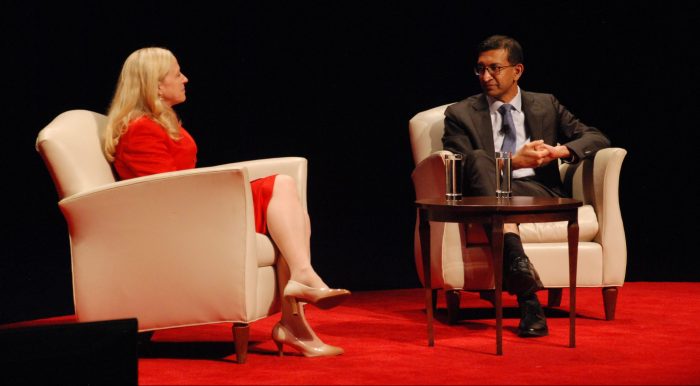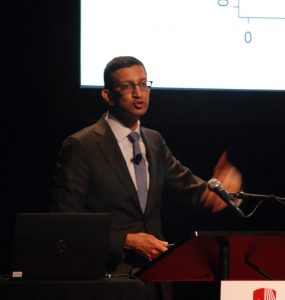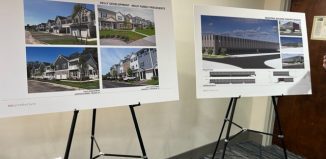Noted economist delivers SBU lecture on social mobility challenges

Economist Raj Chetty gave the Presidential Lecture on the social mobility challenges that young people face at the Charles B. Wang Center, Stony Brook University April 27.
 President Maurie McInnis introduced Chetty as a member of the National Academy of Sciences and a recipient of the MacArthur Fellowship “genius grant” as well as the John Bates Clark Medal, which is given to outstanding economists under the age of 40. Chetty is the William A. Ackman Professor of Public Economics at Harvard University.
President Maurie McInnis introduced Chetty as a member of the National Academy of Sciences and a recipient of the MacArthur Fellowship “genius grant” as well as the John Bates Clark Medal, which is given to outstanding economists under the age of 40. Chetty is the William A. Ackman Professor of Public Economics at Harvard University.
“Professor Chetty authored the now-famous research study on intergenerational mobility that ranked Stony Brook University as a leader among the highly selected public universities in the nation,” McInnis said. “He created a social mobility index, [which] measures how well a university is doing with regard to enrolling a high share of students from low-income communities and then equipping them with the knowledge and skills such that a high proportion of them move into the top 20% of their peer incomes by the time they’re in their 30s.”
After taking the stage, Chetty began by saying that he thinks Stony Brook is “playing a key role in providing pathways to the American Dream for many people.” He described the American Dream as a “multifaceted and complex concept that can mean different things to different people.” He quantified this as children rising above their parents’ income threshold into a higher standard of living.
Chetty said that for people born in the 1940s, it was nearly a guarantee that they would end up more successful financially than their parents. Today it’s basically “a coin flip.”
“This trend is, of course, a great interest to economists like myself because it reflects a fundamental change in the U.S. economy that we’d like to understand,” he said. “But I would argue it’s also a fundamental political and social interest because I think it’s this very trend that underlies a lot of the frustration that people around the United States are expressing that this is no longer a country where it’s easy to get ahead even through hard work.”
“Motivated by this trend in our research group at Harvard Opportunity Insights, we’re focused on the big picture question of what is causing the fading of the American Dream and how can we restore the American Dream going forward,” he added.
Chetty explained that the goal is to discover what is the root cause and to figure out how to increase economic opportunity, as well as “eventually increase economic mobility in the nation as a whole.”
The Harvard professor said that after conducting a variety of different studies in order to find what is “systematically different about the places that have high levels of economic mobility and low levels,” some characteristics of places with high upward mobility were found.
“You will find that these tend to be places with lower poverty rates or places where low-income people and high-income people are living in proximity to each other,” he said, adding that “stable family structures” are key. “It’s a very strong pattern in the data that places with more two-parent families tend to have higher rates of upward mobility.”
Chetty noted that “places with better access to both K-12 elementary education and access to higher quality higher education tend to be places with higher levels of upward mobility.”
The lecturer observed that in some cases the potential for upward economic mobility sometimes changes from one neighborhood to another just a couple miles away. “Motivated by that, one approach you might think about to increase economic opportunity is simply to reduce segregation or help more low-income families move to high opportunity areas,” he said. “And that motivates a set of potential reforms in the context of affordable housing, housing vouchers, zoning laws — lots of things that we can discuss in greater length.”
Chetty said that relocating everyone is not a feasible option, and it is important to discover ways to bring opportunity to low upward mobility areas. “How do you make place-based investments to change the school system or to change other kinds of resources, mentoring programs, other things that might change the trajectory of lives in a given neighborhood?” he said.
The speaker felt that institutions of higher education can play a big role in increasing economic mobility: “I think the problem is even deeper than that, because it’s not just whether you go to college or not — that varies with parental income — it’s which college you go to.”
Two types of U.S. colleges
Chetty discussed how “elite colleges” like Columbia or Harvard do an excellent job of giving their low-income students the opportunity to rise up into a higher sector of financial success, but they do not do a great a job of getting a lot of these students into their school in the first place, since the vast majority of students that attend these universities already come from high-income families.
“We basically seem to have two types of colleges in America,” Chetty said. “We have some colleges which are like Columbia or other peer Ivy League, highly selective private colleges. He noted that these colleges “offer terrific pathways in terms of upward mobility” but “basically cater to the rich.”
“People have thought about these issues for the past decade or two, expanded financial aid and thought about many efforts to address this issue,” he added. “Nevertheless, we’re in this situation where they have predominantly high-income student bodies.
“And then on the other side, you have a set of colleges that do cater to many low-income students, typically two-year colleges or community colleges,” he said. “But, unfortunately, if you look at the outcomes of those colleges, many students are not graduating. You don’t see great outcomes at a number of those colleges. And so those colleges are also not contributing a whole lot to economic mobility because the outcomes don’t look so great.”
He said the “core of the problem” is that there are essentially no universities that cater to low-income students who then go on to become high-income individuals. Chetty acknowledged that this is difficult “because they haven’t had access to the same schools, they haven’t had access to the same resources. If you’re trying to run a highly selective institution that’s taking the most qualified children, maybe there’s just a constraint on how many low-income kids you could get.”
“It’s not just that there’s no kid from a low-income family who’s scoring in the 1500 range on the SAT,” the professor noted. “For some reason, those kids are getting in or attending at much lower rates. Maybe they’re not applying. They’re not choosing to join because of financial aid issues or other things. It suggests that there’s something that’s in the domain of higher education that can potentially be changed.”
Chetty felt that a possible solution is how the University of Michigan conducts targeted outreach to low-income students who have done well in standardized testing to make sure that they are aware that they might be eligible for full scholarships.
“Our sense is that’s going to significantly expand the opportunities those kids have in the years to come,” he said.
He thought another program that could improve this issue is the Accelerated Study in Associate Programs, “a support program for kids once they’re on campus to connect them with mentors to provide additional advising, to provide a little bit of financial assistance if they face an income shock and are not able to pay their tuition or need some additional support.” This is a great way “to shepherd” students through the process instead of just letting them figure out things for themselves, he added.
In conclusion, the professor said, “I’m hopeful that we’re going to have more to say on what colleges can do to increase diversity and have greater impacts on economic mobility, what kinds of changes we can make in the elementary education system, in neighborhoods and so on. And I am hopeful that there will be a receptive audience and policymakers, leaders of institutions and so forth to take that information and make changes going forward.”






